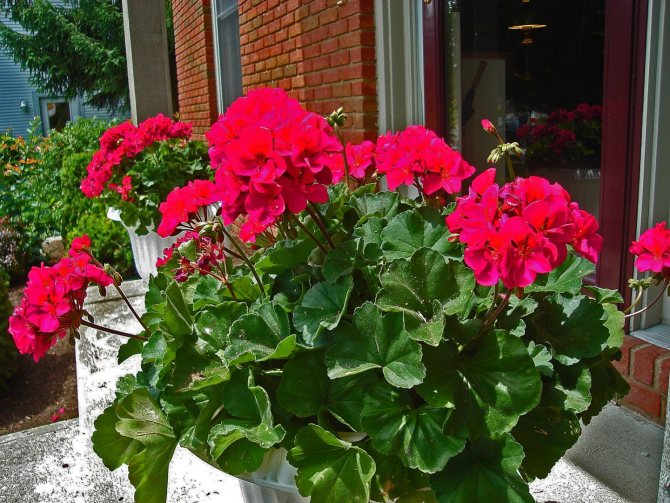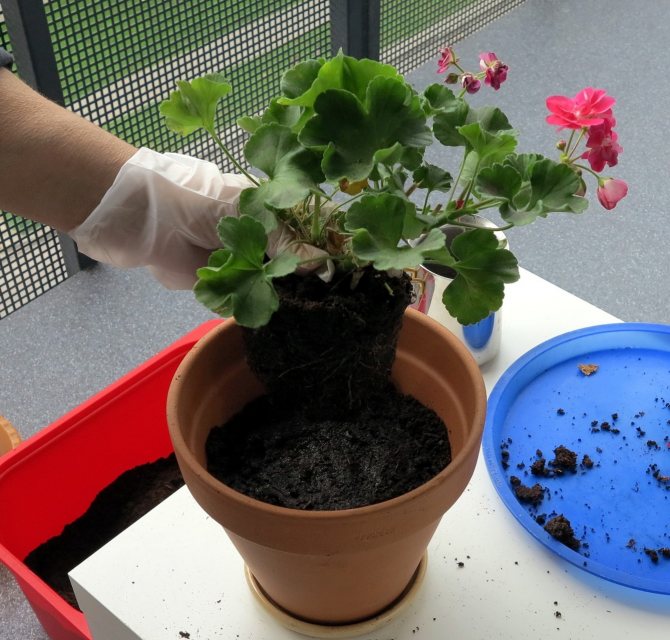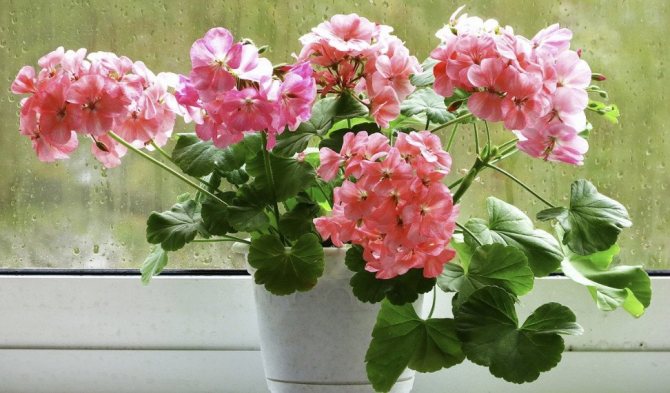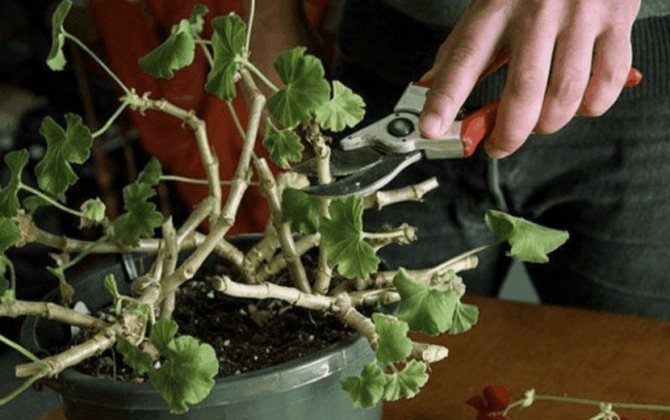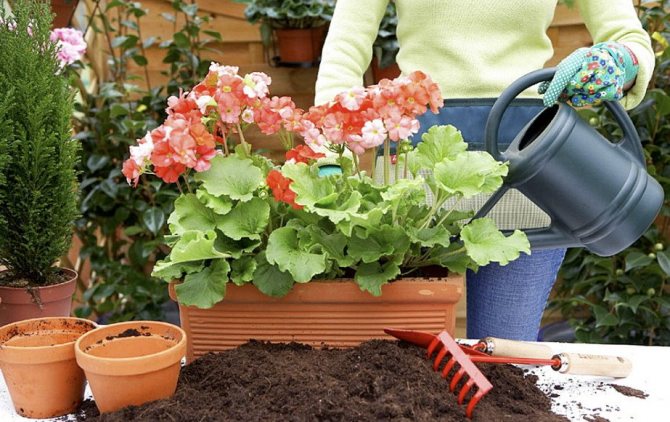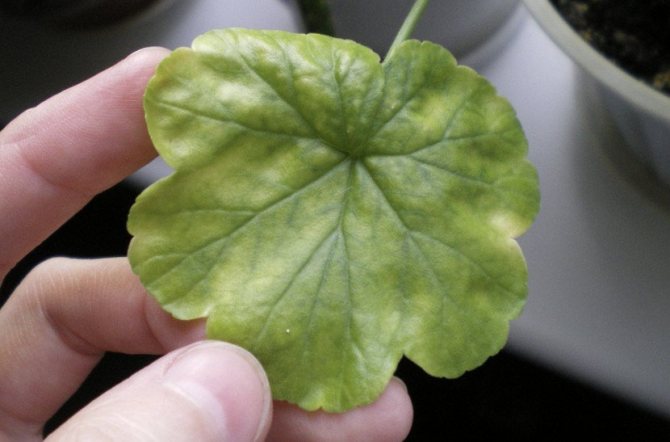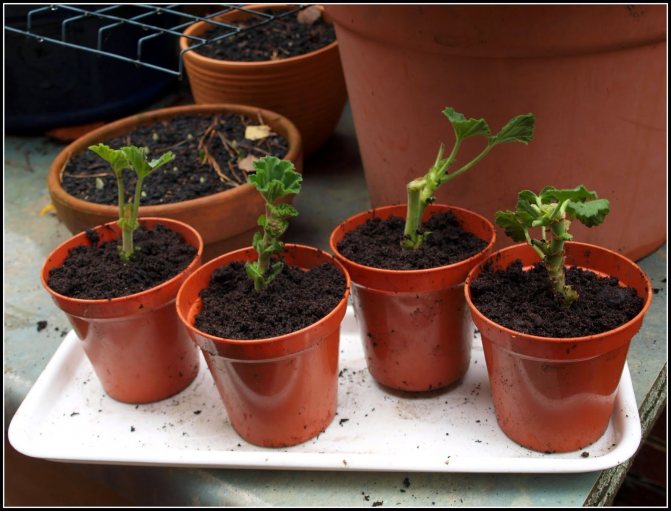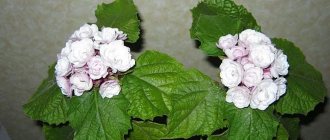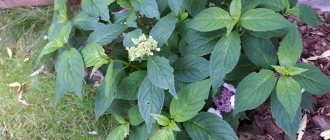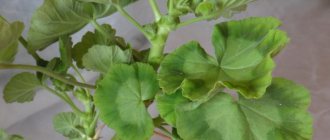When does it release inflorescences and how long does this period last?
If the geranium is located on a loggia or windowsill and receives enough sunlight, flowering begins in early spring and ends by mid-winter. Then the plant rests for 2-3 months and gains strength for a new flowering. However, there are varieties that are capable of producing new inflorescences all year round.
Reference! Geranium is very responsive to proper care. Any variety can be made to bloom for a long time and magnificently, following simple rules.
Features of flowering During the flowering period, geranium actively consumes the energy that it receives in the process of photosynthesis. Mineral substances are also consumed: nitrogen, potassium, phosphorus, iodine, salt.
Geranium throws out peduncles one by one... When one inflorescence begins to fade, another actively blooms. So geranium provides uninterrupted flowering for several months. A plant can simultaneously have from one to one and a half to two dozen inflorescences - it depends on the nutrition of the plant and its age.
Necessary conditions and care
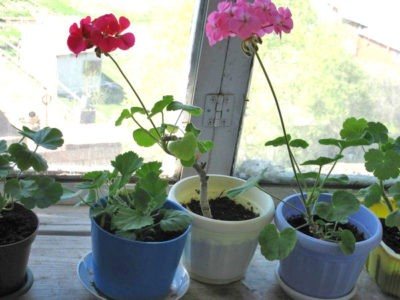
Geranium is an unpretentious plant. But there are some conditions under which it will bloom for a long time and magnificently.
Prerequisites for flowering:
- Adequate lighting.
Geranium loves light and feels bad when it is lacking. The best place for geraniums is an east or south facing window. Before planting geraniums in the garden, you need to find a place with sufficient lighting, protected from strong winds. - Good watering.
Do not overdo it in watering, you need to maintain a balance. The plant is resistant to drought, however, excessive drying of the soil should not be allowed. On hot sunny days, or during a period of active heating, it is necessary to water the geranium daily if the soil in the pot is dry. In the absence of heating, on cool cloudy days, it is enough to water once every 2 days. - Comfort temperature.
In a room where geraniums live, the air temperature should not drop below 12 ° C, otherwise the plant will stop blooming. If in winter the leaves of the plant acquire a red tint, this is a clear sign of freezing. You need to move the geranium away from the ice window. - Timely pruning and plucking.
This technique allows you to enhance branching and increase the number of buds.
Important! Air humidity does not affect the health of the plant, so geranium does not need to be sprayed. On the contrary, spraying provokes a rapid wilting of flowers and a delay in the appearance of new peduncles.
Garden geranium does not bloom
Spectacular perennial garden geranium is considered an unpretentious, shade-tolerant, drought-resistant, frost-resistant crop. This plant, just like the indoor plant, can sometimes have problems with budding, the flower does not bloom for a long time. There are several reasons why geraniums stopped blooming, gardeners distinguish several.
Bushes planted in a brightly lit flower bed, suffering from a lack of moisture, may not please with flowering. It is worth noting that in natural conditions meadow geranium prefers to stay in an openwork shade, in partially illuminated places. This example is a demonstration of the dislike of members of the geranium family for the bright sun.
Under the strong influence of ultraviolet radiation, plants make every effort to retain moisture - their leaves curl, decrease in size, acquire a purple or reddish tint. On the stems, quickly drying nondescript, single flowers can form. The way out of this situation will be to transplant the bush to a more acceptable place.
A significant obstacle to flowering will be damage to the roots of the plant by the wireworm. Having identified signs of wilting in plants in a flower bed, you will need to dig up one copy and examine its root system. After making sure that the cause of the poor state of the geranium is the wireworm, you need to treat the plantings with Aktara. It is also allowed to dig up all geraniums, cleanse their roots from pests, place them in an insecticide solution for a certain time, and plant them on a new site. The soil where the bushes used to grow is treated with the same agent.
Why does a houseplant not bloom at home, but gives only foliage?
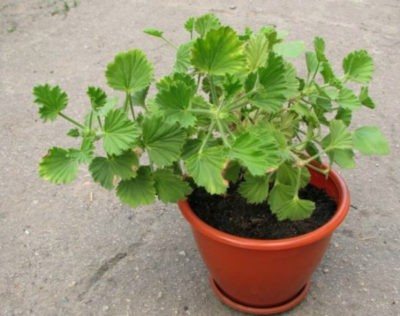

There are many reasons why a plant refuses to produce flower stalks.
Possible reasons for the lack of flowering:
- low room temperature;
- unsuitable poor soil;
- illiterate watering;
- too large a pot;
- untimely pruning or lack of it;
- diseases and pests.
Why does the leaves stretch violently up?
The reason that geranium grows, but does not bloom, may be a lack of light. Geranium gets sick if it lacks sunlight and reaches out to it with all its might. Without sunlight, the plant cannot gain the strength to bloom profusely, hence the long, bare stems.
If the geranium has grown noticeably, and the leaves have become rare, the reason must be sought in watering. Excessive watering provokes rotting of the root system and infection with a fungus... In such conditions, geranium cannot bloom, and its leaves and stems become lifeless and soft.
The geranium that has not been transplanted for a long time does not bloom for a long time. The root system grows actively, and a moment comes when the roots are so crowded that they show up from the drain hole. Another florist's mistake is a pot that is too spacious. The transplanted geranium will not bloom until it takes up the entire volume of the pot with its roots, which will take a lot of time.
Too fertile soil also inhibits flowering.... In such a substrate, the plant will throw out a large number of shoots, grow quickly and acquire leaves, but not flowers.
The stems do not branch, but grow in length without pinching or pruning. Such a geranium does not have the strength to bloom, since all the energy is spent on the exuberant growth of stems and leaves.
Why isn't it growing?
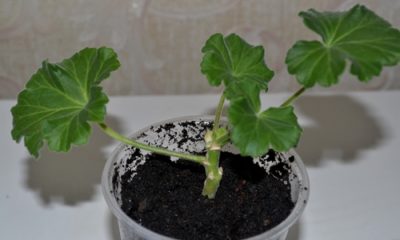

During the hot summer, geraniums may stop forming inflorescences and a bush. Growth stops. Like cold, extreme heat is not good for the plant..
Another reason for the lack of growth and flowering is pests. Geranium is attacked by mites, fungi, mealybugs, due to which it stops growth and flowering. If the plant is not transplanted and treated with a special preparation, it will die.
Geranium is resistant to drought and does not die from lack of watering, but its growth and flowering stops.
The lack and wrong balance of mineral fertilizers negatively affects the health of geranium - it stops growing and blooming. The plant suffers from both a lack of substances in the old soil and an excess of minerals..
Improper watering
To understand why geranium does not bloom, you should first familiarize yourself with the rules for watering it. Pelargonium is more likely to be a drought-resistant plant than a moisture-loving one. Due to excessive watering, this indoor flower withers and stops blooming. Excess moisture damages the root system, leads to its decay.
The quality of the water also affects the state of pelargonium.When watering and spraying with unfiltered cold liquid, the plant can become sick. This leads to darkening and drying of the leaves.


Excessive watering leads to wilting of the plant
To achieve flowering geraniums, it should be watered moderately and evenly. Watering should be more frequent in summer than in winter. But in any case, the procedure should be carried out only when the top layer of the soil dries out. Water at room temperature should be filtered and carefully poured onto the soil near the side of the pot, trying to avoid getting it on the stems and leaves of the pelargonium. Any excess liquid accumulated in the pan must be discarded immediately.
Do not overuse geranium spraying. In the heat, you can slightly moisten the leaves with a spray bottle.
How to feed?
In the period from the beginning of spring to the end of summer, geraniums need fertilizing. Nitrogen, phosphorus and potassium must be in balance for the simultaneous growth and development of inflorescences, stems, leaves and roots. For example, the mineral fertilizer should not be allowed to contain more than 11% nitrogen, otherwise geranium will not bloom.
In the warm season, it is advisable to put the pot on the balcony. - the abundance of light, together with the difference between day and night temperatures, stimulates abundant flowering. As soon as the inflorescence begins to fade, it is worth breaking off or cutting it off. This way you can achieve a longer flowering.
In winter, during the rest period, indoor non-flowering geraniums cannot be fed, and watering must be done no more than 1 time in 10 days.
Reference! Geraniums are very sensitive to habitat changes. Frequent changes in the location and position of the pot negatively affect flowering.
We suggest you watch a video about feeding geraniums:
General principles of cultivation
In nature, geranium grows in rather harsh conditions. Most people begin to water, fertilize and feed this flower abundantly. Because of this, geranium begins to really grow. This is the most common answer to the question "Why does geranium not bloom?" Instead of beautiful and bright buds, only green leaves appear. In this case, you need to start caring for geraniums in a more strict environment. Then she will begin to feel that she is dying, and at this time she will begin to leave offspring, that is, buds will begin to appear.
Pruning and replanting


In early March, when the resting period ends, geraniums need pruning to form a dense crown and stimulate abundant flowering. It is necessary to cut off old leaves, and leave no more than 5 buds on each shoot. Shoots growing from leaf sinuses are removed.
It is necessary to change the substrate to a new one every year. You can keep the old pot, or buy a pot a little larger than the old one. You cannot transplant the plant into a pot that is too large, otherwise the geranium will stop flowering for a long time.
Transplanting outdoors has a beneficial effect on plant health... However, it is possible to plant only when the likelihood of strong changes in day and night air temperature disappears. After staying in the garden, the geranium must be returned to the pot with fresh soil and pruned.
We suggest you watch a video about pruning geraniums:
We suggest you watch a video about a geranium transplant:
Why prune geraniums
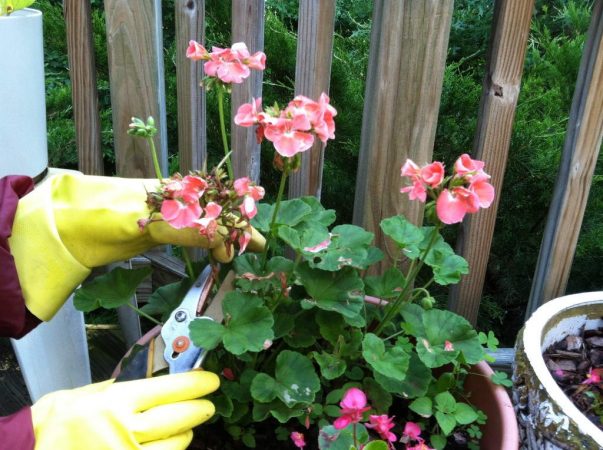

Getting rid of unnecessary branches, and this is precisely what pruning a geranium bush consists in, allows you to achieve the following goals:
- to form the conceived shape of the flower crown;
- activate the release of lateral branches (dormant buds sitting in each internode, without outside interference in growth, do not touch);
- speed up metabolic processes;
- establish high-quality air exchange, improving aeration inside the geranium bush;
- ensure uniform illumination of all parts of the pelargonium;
- stimulate more abundant and long-lasting flowering;
- to prevent the appearance and development of fungal pathologies caused by excessive thickening of the ground part.
After each thorough pruning of geraniums, many cut shoots remain, which can then be rooted in water or immediately in the substrate.
What to do for flowering?
Flowering stimulation rules:
- If the pot in which the geranium lives is large enough, you should change it in favor of a small one. The plant will bloom in a small pot, where it does not have to develop a root system for a long time.
- To stimulate flowering, experienced florists advise changing the soil once a year. Replacing old soil with fresh and nutritious ones gives a powerful impetus to flowering.
- The plant needs sunlight. The pot should be on a windowsill or balcony lit by the sun's rays. Cover the glass with white paper to prevent burns from direct sunlight.
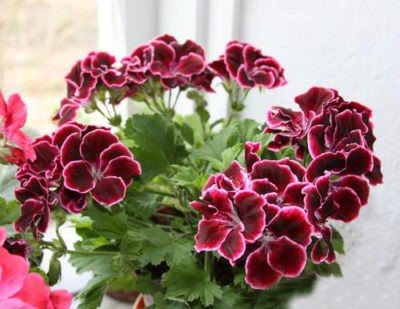

Watering should be moderate. It is worth watering only when the earthen lump in the pot is already dry enough.- For abundant flowering, it is advised to add magnesium sulfate to the soil. This fertilizer helps to increase the number of inflorescences. Iodine water is also popular: 1 drop of iodine is added to 1 liter of water. The plant is watered with this solution in the amount of 50 ml. Florists note that iodine stimulates lush and long flowering. You can only feed it from the beginning of spring to the end of summer.
- During the flowering period, it is unacceptable for drops of water to enter the buds, and it is also prohibited to treat the plant from pests. These actions contribute to the early completion of flowering and a long break.
- The temperature difference has a stimulating effect on geraniums. The plant, which lives in the summer on a balcony or loggia, blooms luxuriantly and for a long time. In summer, the air temperature in the place where the geranium is located should not fall below 12-15 ° C.
- A good winter vacation will bear fruit in the form of abundant flowering. In winter, the geranium pot should be kept in a cool place. Watering can be done no more than 3 times a month.
Geranium is more than a houseplant. Geranium lovers note that the bright flowers and delicate scent of the leaves have a beneficial effect on mood and well-being. For geraniums to be healthy and bloom magnificently, you do not have to make serious efforts. Simple rules will help turn this plant into a beautiful and useful decoration for your apartment.
Pruning geraniums in spring for lush bloom
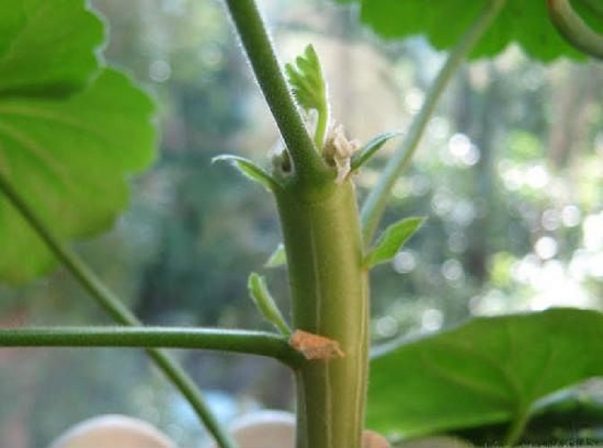

Since the days are short in winter and the nights are long, geraniums often suffer from a lack of light. At the same time, they are disproportionately and ugly stretched. Seasonal spring pruning measures are carried out not only in order to preserve decorativeness, but also to increase the number of flower buds and leaves forming on pelargonium.
Geranium, after properly pruning, designed to obtain a more lush and abundant flowering, looks much neater. This should be done at the very end of winter (February) or in the very first spring week (early March), when the flower has not finally woken up and has not started to grow. Pruning inevitably pushes back the beginning of flowering, so the earlier you do it, the sooner the bush will recover and release buds.
Pelargonium pruning step by step
In the spring, geraniums are not radically cut, the procedure is, rather, of a sanitary nature:
- First of all, sick, damaged and dried shoots are removed.
- Tear off dried leaves.
- Remove curves, excess, as well as growing in the center and thickening the bush stems.
- Overly stretched and bare branches that are knocked out of the general format are pruned.
- Root shoots and lower lateral layers are also cut off.
- All remaining strong and healthy stems are cut by about a third, making a cut slightly higher (3-5 mm) located on the outside of the stem of the kidney.
You need to work only with sharply sharpened and disinfected tools (alcohol, vodka, etc.).Places of cuts are dusted with mustard or coal powder (you can cauterize with brilliant green).
When pruning geraniums at any time of the year, it is better to use a small thin (for example, office) knife or blade at home, because pruning shears or scissors severely injure green plant tissues.
Care after pruning
In order for the geranium bush to recover quickly after the pruning, it needs to create several gentle conditions:
- provide normal and acceptable air humidity, periodically spraying;
- slowly and carefully adjust and normalize the watering regime;
- provide geraniums with maximum light by placing it on the lightest window sill (preferably the southern one);
- create the necessary, slightly warmer conditions by raising the temperature (compared to winter content) by 3 ... 5 ° C;
- feed with any universal nitrogen-containing fertilizer for flowering indoor crops (Hera, Agricola, etc.).


